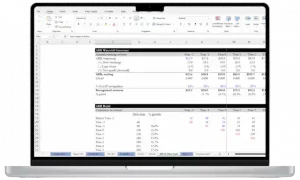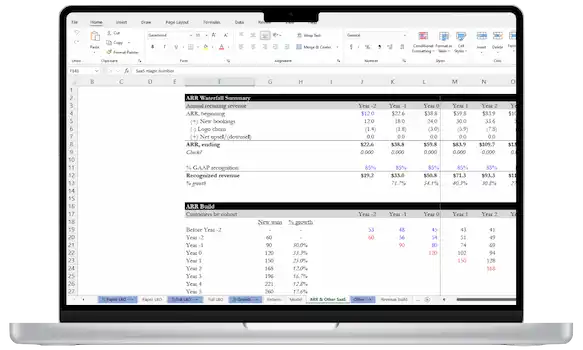The difference between gross revenue retention (GRR) versus net revenue retention (NRR) for SaaS metrics is subtle but important. Each can tell you something different about a business, and both have an important role to play in monitoring the health of a software company.
Gross Retention vs. Net Retention: What’s the difference?
The simple answer is that net revenue retention (NRR) includes expansion revenue (revenue increases from existing customers) while gross revenue retention (GRR) does not.
The longer answer is that they let you focus your analysis in a different way. Since net retention includes expansion, the metric allows you to understand how well the company is both retaining and upselling existing customers.
Gross retention, on the other hand, helps you isolate a company’s ability to retain customers at their current plan level via customer success efforts (without clouding the picture from the effect of upsells).
Overall, NRR is a more popular metric than GRR.
What is Net Revenue Retention (NRR)?
Net Revenue Retention is one of the top metrics investors use to assess the health of an SaaS company.
NRR is a measure of how much recurring revenue your company keeps, including new recurring revenue, in a given time period. Since it includes revenue newly added from existing customers (“expansion revenue”) but not new growth, NRR is a metric that looks at the company’s ability to not only retain happy customers, but make them so satisfied that they continue to expand their use of your software every year.
A focus on NRR over time can lead to increased activities aimed at expanding the company’s most valuable clients, usually in the form of custom packages or upsell offers.
How to calculate the Net Revenue Retention rate?
Net Revenue Retention is calculated as follows:
(Beginning MRR + expansion MRR – churn $)/Beginning MRR
This figure gives you a good idea of not only how much you are expanding each month, but also how well you are retaining the customers you have. Both the expansion and the churn have to be at healthy levels in order to have a great net revenue retention rate.
As a reminder, the expansion revenue is only expanded subscription revenue from existing customers you already had. This metric does not account for MRR from new customers added during the period.
Net Revenue Retention rate example
For example, suppose your SaaS company had a beginning MRR of $10,000 per month. You had 20 customers increase their subscriptions by $100 per month, and 2 customers who churned. The churned customers had been spending $50 per month on their subscription.
Beginning period MRR: $10,000 per month
Expansion MRR: $2,000
Churn: $100
Following the formula above we have:
(10,000 + 2,000 – 100)/10,000 = 120%
This would be an excellent NRR, as it shows that the company will continue to grow by 20% each period even without getting any new customers. That’d be great!
A company with a healthy NRR like this can afford to focus less on attracting new customers – however, it indicates that if they did go after new customers (assuming they are similar to previous ones) they’d be very likely to stick around for awhile.
Now let’s look at a worse NRR situation. This SaaS company was doing well last year, but now faces significant competition from a new software that has entered the market. They have a MRR of $10,000. In this period, they had 10 customers who chose to expand their existing subscriptions by $50 per month, and 20 customers who churned, leaving their $50/month subscriptions. Now, the NRR equation looks like this:
(10,000 + 500 – 1,000)/10,000 = 95%
In this situation, the company is losing more revenue than it gains from its existing customers. In order to grow, they must invest money into attracting new customers. This isn’t all, though. In order to avoid a negative impact on CAC costs and CAC payback period, management will also have to see what is causing the existing customers to leave, and take measures to improve retention.
Note, 95% NRR is usually not considered “bad.” Every situation and industry is different, but for most situations this would still be a very healthy retention rate!

- 33 lessons
- 8+ video hours
- Excels & templates
What is Gross Revenue Retention (GRR)?
Gross revenue retention is very similar to net revenue retention, with one key difference: it leaves out expansion revenue. This small difference means that GRR tells you an entirely different story about your business.
GRR only looks at how well you can retain customers, without accounting for how well your company can upsell them. GRR is also sometimes expressed in terms of customers rather than dollars. In these cases, GRR becomes customer retention.
You may think that this metric isn’t very important, and in a way, you’re right – it’s not used as often as NRR.
However, it can be valuable depending on your business model. If you have a less-differentiated SaaS product, you have a higher risk of churn than a product with a high degree of customization or personalization for enterprise clients and other high-value customers.
Analyzing GRR can still be valuable since it isolates the ability to retain and hold onto customer accounts. If you sought to improve GRR you might seek to focus on the onboarding process for all clients, and customer satisfaction activities across the board.
How to calculate the Gross Revenue Retention rate?
GRR is calculated as follows:
(Beginning MRR – Churn – Contractions)/Beginning MRR
As you can see, the focus here is on keeping churn and contractions as low as possible. Interestingly enough, a well-established SaaS company will often have a higher GRR rate than a newer company.
An SaaS company in its first few years has not had many contracts expire yet, so customers don’t have the choice to churn yet, leading to an apparent GRR rate close to 100%.
Once a company has been around for a while, it will have a higher percentage of customer who churn or contract every month. This will lower GRR. As long as the churn percentage stays in a normal range – usually 3-5% – the drop in GRR is normal and expected.
Gross Revenue Retention rate example
Let’s use the same company from our first example. The company has an MRR of $10,000, expansion MRR of $2,000 per month, and churn of $100. The GRR equation looks like this:
(10,000 – 100)/10,000 = 99%
Note that expansion revenue is not included in this calculation.
How to improve retention
Good retention begins at the very start of a customer’s experience: the onboarding process. Thorough onboarding means more customers who know how to make the best use of your product.
It also means that your software is going to be the easiest for them to use, since you have their information in your system already.
This increases customer satisfaction and decreases churn. First, the customers know enough about how your product works to use it successfully and without frustration. Second, they know that they invested the time and effort necessary to learn about the product and will be less willing to go through that process again with a competing product.
After onboarding, you can increase retention through:
- Clear expectations about what your product does and doesn’t do
- Responsive customer service
- New value-added updates
- Cross-sells and upsells
- Straightforward customer reward points or loyalty programs
The key to all these things is keeping your product easy to use and increasingly valuable. Customers don’t want updates that change everything they thought they knew about your product, or rewards programs where the point system is unclear. Frustration is one of the biggest drivers of churn.
FAQ: What is GRR and NRR?
GRR = Gross Revenue Retention. GRR is calculated by comparing the end-of-period revenue from existing customers to the beginning recurring revenue for existing customers, not including expansion revenue during the period. This is a measure of how well a company retains its existing customers each period.
NRR = Net Revenue Retention. NRR is calculated by comparing the end-of-period software revenue from existing customers, including expansion revenue, to the beginning recurring revenue for the period. This is a measure of how well a company not only retains its customers, but makes each one more valuable to the company.
Neither one of these metrics accounts for new MRR added by new customers during the period, as these metrics are solely focused on existing customers.
While there are other valuable metrics, such as CAC and the LTV-to-CAC ratio, that do focus on new customer acquisition, NRR and GRR focus on the company’s existing clients. This is because retention activities are less costly than new customer acquisition, leading to a higher return on each client.
FAQ: What is good gross retention?
Since gross retention does not include any new revenue, the maximum possible value is 100%. However, since a small churn rate is expected in business, the GRR rate is going to be less than 100%.
For SaaS companies serving small- to medium-size businesses or B2C applications, a good gross retention rate is around 80%. For solely B2C products, the GRR rate may be even lower than this.
For SaaS companies serving larger businesses and enterprise clients, a good GRR rate is considered closer to 90-95%. This is for two main reasons. First, these clients usually have a larger budget and are higher spenders on their software solutions.
For the SaaS company, the loss of even one of these clients means a larger effect on the company’s bottom line. Second, these clients are sometimes easier to retain. They are more likely to do research into which software solution works best for their exact needs, so when they choose yours, they know you have exactly what they need. Due to their size, they have a longer onboarding and implementation process, and may need to invest time to train multiple employees on the new platform.
Because of this, they will be less likely to leave and switch to a different product, as they have a much higher conversion cost to switch to anything else.
Next steps
Check out my series on SaaS and growth metrics to learn more. Also, if you’d like to dive deep, reserve your spot in our online course on SaaS metrics and financial modeling.


 SaaS & Growth Metrics
SaaS & Growth Metrics Break Into Growth Equity
Break Into Growth Equity
